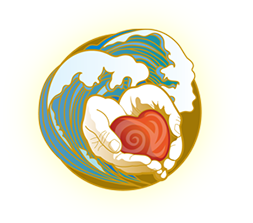
Traditionally called the midline in Osteopathic and Craniosacral literature, the open spaces in and around our spine are much wider and thicker than a line and better imagined as the trunk of a tree or road. Long-time Biodynamic Craniosacral teacher and practitioner Anna Chitty coined the term mid-space to more accurately describe the anatomy and experience of our mid-line. The mid-space is what it sounds like: The space in the middle. The body is beautifully crafted to maintain spaciousness in its center. The mid-space is a place each person can orient to within themselves and is where the body naturally orients to. While our mid-space is always there, we can come into more relationship to it in any moment. Orienting to our mid-space is a way of coming into relationship with ourselves.
Let’s consider the anatomy of the mid-space, beginning with the spine. Each vertebrae is crafted to support and adjust to the body’s movement patterns. The transverse processes of the vertebrae embrace the membranous sac which contains the spinal cord. This sac is made of dura mater which means “tough mother” in Latin and is as any truly tough mother is – strong and protective of the ones in her care, so they are not only safe but also allowed to flourish.
The brain and spinal cord, which together comprise the central nervous system, are protected by the surrounding dura and are continuously bathed and potentized by the rhythmic flow of cerebrospinal fluid (CSF). This rhythmic fluid flow, also known in our field as Primary Respiration, is our ongoing connection to the essence that formed us and is endlessly informing us. The submersion of the central nervous system in CSF supports and maintains its fluidity and buoyancy. Consider for a moment the reciprocity occurring between the cerebrospinal fluid and the central nervous system. The brain is not only bathed by CSF, it also produces it in both its capillaries and a tissue structure called the choroid plexus found within the spaces inside the brain known as ventricles. The central nervous system both replenishes and is replenished by the cerebrospinal fluid. The CSF in turn both supports the brain and is supported by its production of CSF.
The body’s ability to be moistened by its own fluids is known as motility. Healthy motility of the central nervous system, and in fact all the tissues and structures in the body, is an expression of vitality and well-being. Motility is also an expression of both the healthy relationship of fluids and tissues within themselves and an expression of their connectedness to each other.
For me, Biodynamic Craniosacral Therapy is the ongoing dance between the presence or absence of motility within my relationship to myself and my relationships to others. Some days I can feel the motility and connection in a relationship; other days I feel the searing familiarity of disconnection. In my disconnected moments, sometimes I am still connected enough to remind myself that relationships like the rest of life, are not meant to be mastered, only improved. One of the most reliable routes for me to return to balance is to journey back to my mid-space.
Below is an exercise to support you to explore your mid-space. Remember, even the attempt to disengage from a difficult experience or memory and orient to your body now, will bring you closer to the present moment.
Enjoy!
Orienting to Mid-Space:
- Sit comfortably and begin to orient to your body. Notice your body as a place and let yourself notice where you are just now, the feel of the objects you are touching, the feel of your clothes, the weight of your body against the surfaces you are touching. Establish a felt sense of the ground below you and use that felt sense to orient to the ground within you as well.
- Maintain your sense of the ground below you and within you as you sense your skin and the space just outside your body. Then remember the space inside your body and see if you can sense it simultaneously. Notice what happens. Gently weave your attention back and forth between your skin and your center.
- As you orient to the center or mid-space, notice your felt sense experience of mid-space. Allow yourself to inhabit your own mid-space more. Notice what that does. Consider the fluid and potency moving through this center right now. Notice what that knowing does.
- Enjoy your discoveries here. Let them help you remember what you already know. Let your mid-space both deepen and widen, like an ancient tree which is firmly established in both depth and girth.
- When you are ready to shift, consider again the space around you before you open your eyes. Find your own curiosity and readiness to explore the visual world. Feel how both your sight and your ability for insight are heightened. Pause here and honor the ability of your mid-space to orient you both to yourself and the world – and then enjoy experiencing your world from a more centered, grounded and spacious place!

